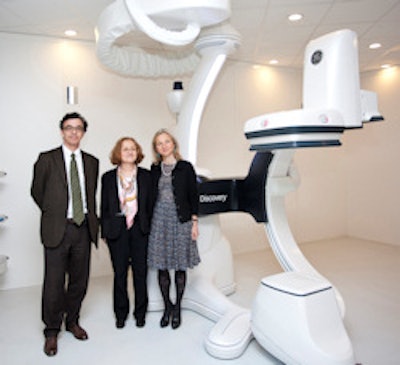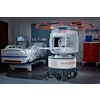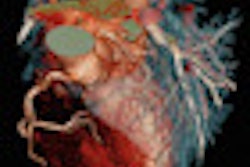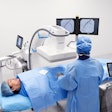
PARIS - GE Healthcare opened the doors of its development lab yesterday to unveil the first production model of the Discovery IGS 730 interventional radiology system. The first units are due to begin shipping by September, and the company expects to produce 50 machines in the first year.
The device received 510(k) clearance from the U.S. Food and Drug Administration last month and is expected to receive a CE Mark for commercialization in Europe once the production line is certified this summer. Introduced in November 2011 at the RSNA meeting, the new system breaks the paradigm in hybrid operating room (OR) design that forces a decision between floor- or ceiling-mounted imaging systems. Mounted on a mobile base that is controlled by a laser-precision positioning system, the device glides around the OR, bringing high-end imaging capabilities to the patient table, but backing out to a parked position if an intervention converts to open surgery, according to GE.
 Executives display the Discovery IGS 730 in the development lab in Buc, France. From the left are Dr. Robert Sigal, president of GE Healthcare France; Chantal Le Chat, general manager of GE Healthcare Interventional Radiology; and Clara Gaymard, president of GE France.
Executives display the Discovery IGS 730 in the development lab in Buc, France. From the left are Dr. Robert Sigal, president of GE Healthcare France; Chantal Le Chat, general manager of GE Healthcare Interventional Radiology; and Clara Gaymard, president of GE France.
"The system always knows precisely where it is, constantly triangulating its position against special reflectors on the walls," said Hooman Hakami, president and CEO of Interventional Systems. "It is a system that fits to the room, so you don't need to build the room around the system."
Hakami declined to name the first sites to install the system, but said both the U.S. and Europe were likely to have simultaneous installations before the end of 2012.
The advantage over a mobile C-arm is the system is hard-wired like a fixed floor or ceiling unit so it offers high-end imaging capabilities, and it can go the distance for complex interventions, stated product line manager Delphine Germain.
The product's gantry features a new wide-bore C-arm capable of steep angles and 3D dataset acquisitions. Linked to the GE Advantage workstation, it features more than 20 advanced imaging applications, including TrackVision to guide ablation needle procedures, and the fusion of anatomical and functional images from CT, MRI, PET, and SPECT to help plan or assess interventional procedures.
In the competitive market for hybrid OR, the mobile floor unit frees valuable overhead space and removes the risk of infection from dust and debris that falls from a ceiling track, noted Chantal Le Chat, general manager of GE Healthcare Interventional Radiology. Against fixed floor-mounted systems, the advantage of Discovery IGS 730 is its motorized mobility, she said.
The system was conceived, developed, and built in Buc, just outside Paris, in a former aircraft hangar designed by Gustave Eiffel. The motorized base for the gantry builds on a platform supplied by BA Systèmes in Mordelles, France. The human control interface was developed by C&K Components in Serris, France.



















